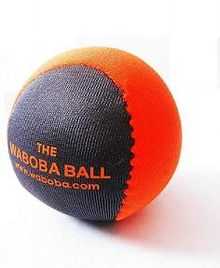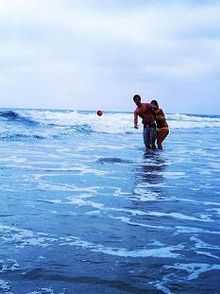Waboba

Waboba is an outdoor toy and sporting goods brand based in Stockholm, Sweden and with offices in Guangzhou, China and Atlanta, Georgia. Waboba is the creator of the original balls that bounce on water. Even though Waboba began with “the ball that bounces on water” in 2005, it has since expanded to introduce a range of accessories and land items.The slogan used in advertising is Keep Life Fun. The name Waboba is a registered trademark and the balls are internationally patented.
Name
Even though Waboba is short for WAter BOuncing BAll, the name is specific to the brand and its products only.
History
In Sweden in the early 1980s, inventor Jan von Heland got the idea of creating something that bounces on water after throwing a Frisbee upside down and noticing it skims the surface of water. Much like skipping a rock. Over the years, he began to tests different shapes, materials and compositions until he discovered in 2002 that a ball could bounce on water if made of the proper materials.[1] In 2004, Jan created the formula for creating a ball that bounces on water, and eventually patented what has become the Waboba Ball.[2] T
The ball composition is made of different types of Polyurethane covered in Lycra, allowing it to bounce on water and float.[1] Its patented design and durability gives Waboba its superior quality. To bounce the ball on the water, one must throw like skipping a rock. The ball bounces high on the water in between players when thrown at the right angle (overhand) with the right force.[1] The ball does not bounce on land. [1]
In 2005, The Waboba Ball - the first ball to bounce on water, is introduced to the market and later evolves into the Waboba Extreme. To date, there are now 6 different types of Waboba balls that bounce on water (Pro, Extreme, Surf, Blast, Big Kahuna, and Fetch) as well as several land items and accessories.
Geographical spread
The Waboba Ball was first introduced in Sweden in 2005 where it sold for two years before it was introduced to new markets in Europe, United States and Australia in the summer of 2007. In summer 2008, Waboba entered markets in Canada, South Africa, and the United Kingdom. During the fall of 2008 and spring 2009, Waboba was introduced in Brazil, China, Singapore, Kuwait, Dubai, Germany, Portugal, Scandinavia, France, Spain, and Cyprus. By 2013, Waboba is present in all European countries and continents except Antarctica [3]
Products
Water Bouncing Balls
- Pro - engineered for athletic control and accuracy in the lake or ocean.
- Extreme - bounces fast, far, and high in the lake or ocean.
- Surf, for beginners. It’s soft and easy to handle in the lake or ocean.
- Big Kahuna, the biggest and most versatile Waboba ball for all water environments - lakes, oceans, and pools.
- Blast, engineered for pool play.
- Fetch, water-retrieval ball for dogs [3]
Water Accessories
- Catch - neoprene glove paired with the Waboba Pro for water play
- Waboba Lacrosse - in 2014, Waboba partnered with STX to release water lacrosse using FiddleSTX and a Waboba Extreme ball.[3]
Land Items
- Moon - super high-bouncing land ball
- Street - unusual shape gives it an unpredictable bounce
- Flyer - an oversized shuttlecock that lets you hit it with your hands, knees, feet, or rackets.[3]
Awards
- Special Needs Approved by AblePlay [4]
- Dr. Toy Best Toy for Vacation [5]
- Gold Award, Family Review Center [6]
- Moon Ball 2013 Toy of the Year Award winner by Creative Child Magazine [7]
The game

Official Match Game
The object of the 4v4 game is to bounce the Waboba Pro on the water in order to pass to team members and score points by bouncing the ball into a goal.
Described as a cross between ultimate frisbee and water polo, the official match game is a team water sport played with the Pro ball that bounces on water. Teams consist of 3 field players, a goalkeeper and 2 substitutes. The winner of the game is the team that scores the most goals. The object of the game is to pass the ball with at least one bounce on water between team members in order to score goals. No direct passes allowed. There are no offside rules so teams have the ability to spread players across the game field, facilitating long, uninterrupted passes.[8]
Ultimate Waboba
Use any Waboba ball. Each team, a minimum of 3 players per team, passes the Waboba to each other to complete a round. A team gets 1 point when each team member has caught the ball without interruption from the opposing team. A pass must bounce on the water before being caught. First team to 3 points wins. Passes have to be made within 5 seconds after receiving the ball. No holding players allowed.[8]
Physics
An elastic ball that bounces on water, the Waboba water balls flatten like a pancake when they hits the water surface, increasing its lift and propelling it upward. When it hits the water at a shallow angle, it too creates a bowl-shaped depression. But because it is soft, the ball flattens into a disc-shape when it hits the surface and this allows it to aquaplane efficiently across the surface. And the angle of the bowl-shaped depression causes it to launch into the air where the ball regains its shape, making it look as if it has bounced. The process is remarkably similar to the way stones skip across water, even though they are denser than the liquid. A shallow impact with the water surface creates a bowl-shaped depression that launches the stone into the air as it leaves.[9]
Naval use
Researchers with the U.S. Navy’s University Laboratory Initiative have been studying the mechanics and elasticity of the Waboba balls. The military branch is interested in how elasticity affects motion in water.[10]
References
- ↑ 1.0 1.1 1.2 http://www.telegraph.co.uk/news/newstopics/howaboutthat/2484555/Ball-that-bounces-on-water-is-latest-beach-toy.html
- ↑ http://www.gizmag.com/reinventing-mans-oldest-plaything-the-woboba-ball-bounces-on-water/9160/
- ↑ 3.0 3.1 3.2 3.3 http://waboba.com/
- ↑ http://www.ableplay.org/products/waboba/waboba-bounces-water
- ↑ http://www.drtoy.com/product-view/?productid=2710
- ↑ http://www.prlog.org/12138278-family-review-center-is-proud-to-announce-that-waboba-balls-have-won-the-gold-award.html
- ↑ http://www.creativechild.com/toy-guide/outdoor_play/creative_outdoor_play
- ↑ 8.0 8.1 http://waboba.com/howtoplay
- ↑ http://www.technologyreview.com/view/425827/like-stones-why-some-balls-bounce-on-water/
- ↑ http://www.livescience.com/43917-toy-physics-waboba-ball.html